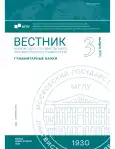MVHVΛV: towards the Interpretation of the Tuscan Epigraphic Inscription
- 作者: Valkov D.V.1
-
隶属关系:
- Russian Presidential Academy of National Economy and Public Administration, Moscow State Linguistic University
- 期: 编号 3(897) (2025)
- 页面: 9-16
- 栏目: Linguistics
- URL: https://journal-vniispk.ru/2542-2197/article/view/286259
- ID: 286259
如何引用文章
全文:
详细
The purpose of the article is to reinterpret the content and historical context of the inscription MVHVΛV available in the medieval Tuscan epigraphic material. The structure of military-political and cultural contacts of Tuscany in the VIII – 1st half of the XII century, as well as a number of objections related to the Michaelic interpretation, makes it possible to reinterpret the inscription MVHVΛV based on the Quranic substrate: as a transmission through the Latin graphics of the Quranic exclamation mā šāʾ Allāh. The inscription MVHVΛV, as well as monuments of Islamic Arabographic epigraphy of the X–XII centuries, embedded in the urban space of Christian Pisa, acquired in this connotation an ideological, apotropaic and invocative meaning.
作者简介
Dmitry Valkov
Russian Presidential Academy of National Economy and Public Administration, Moscow State Linguistic University
编辑信件的主要联系方式.
Email: valkovdv@yandex.ru
PhD (History), Associate Professor
Lecturer at the Department of Second Foreign Languages of the RANEPA General Academic Faculty
Associate Professor at the Department of Phonetics and Grammar of the French Language, Faculty of French Language at MSLU
俄罗斯联邦参考
- Guarducci, M. (1959). La misteriosa iscrizione medievale di Pisa, Barga e Lucca. In Atti della Accademia Nazionale dei Lincei. Classe di scienze morali, storiche e filologiche. Rendiconti. Ser. VIII. Vol. XIV, fasc. 5–6, 216–224, tav. I–IV.
- Banti, O. (1995a). Simbolismo religioso e stilizzazione grafica in una iscrizione longobarda del secolo VIII. In Banti, O. Scritti di storia, diplomatica ed epigrafia. Ed. by S. P. P. Scalfati. 21–38. Pisa: Pacini Editore.
- Arrighi, G. (1968). La iscrizione criptografica di Lucca, Pisa e Barga. In Rassegna periodica del Comune di Pisa, IV(4), 22–31.
- Banti, O. (1995b). Epigrafi medievali pisane nel Museo Nazionale di San Matteo. In Banti, O. Scritti di storia, diplomatica ed epigrafia (pp. 181–198). Ed. by S. P. P. Scalfati. Pisa: Pacini Editore.
- Banti, O. (2000). Monumenta epigraphica pisana saeculi XV antiquiora. Pisa: Pacini Editore.
- Pasini, D. (2015). Ancora sull’epigrafe con triplice invocazione all’arcangelo Michele. GRADUS. Rivista di Archeologia e di Restauro, 1, 18–24.
- Vicari, St., Perono Cacciafoco, F. (2023). A Puzzling Religious Inscription from Medieval Tuscany: Symbology and Interpretation. Histories, 3, 219–230.
- Wroth, W. (Ed.). (1911). Catalogue of the coins of the Vandals, Ostrogoths and Lombard in the British Museum. London: Longmans and Co.
- Grierson, Ph., Blackburn, M. (2007). Medieval European Coinage. Vol. I. The Early Middle Ages (Vth–Xth Centuries). Cambridge: Cambridge University Press.
- Renzi Rizzo, C. (2011). La Toscana e il mare nelle fonti scritte dei secoli VIII–XI. In Petralia, G. (Ed.), I sistemi portuali della Toscana mediterranea. Infrastrutture, scambi, economie dall’antichità ad oggi (pp. 59–80). Pisa; Ospedaletto: Pacini Editore.
补充文件










